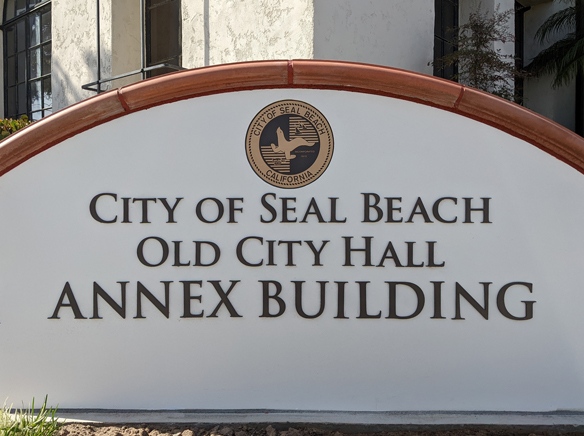The Planning Commission on April 15 voted 4-1 to recommend that the City Council approve proposed guidelines for business uses for Main Street sidewalks.
District Four Commissioner Patty Campbell cast the dissenting votes. After the meeting, she said she voted no because people didn’t support the guidelines as written. During the meeting, Campbell asked the audience how many of them supported the proposal. No hands went up.
However, during the public hearing, Main Street area business owners supported outdoor dining but caller for help for retailers.
The proposed Outdoor Uses Program would require an amendment to the Main Street Specific Plan. Only the council can amend the Specific Plan.
The commissioners discussed a further look at the 8-foot clearance requirement. Community Development Director Alexa Smittle acknowledged that the space would be an issue for some locations. She said there was another pathway depending on the permit being applied for.
District Three Commissioner/Chair Richard Coles initially proposed continuing the hearing for further discussion, but ultimately joined the vote approving the proposed program.
District Five Commissioner Margo Wheeler wanted an opportunity for retailers to have outdoor displays.
The commission did include some changes in their recommendation:
• The proposed program needed to bolster revocation of a permit
• Merchandise should be the same standards as dining
• Ensure maintenance of the outdoor uses
Background
“The Main Street Specific Plan (MSSP) adopted by the City Council on July 8, 1996 serves as a comprehensive regulatory framework guiding land use and development within the Main Street area of the city,” according to the staff report prepared by Management Analyst Megan Coats and Community Development Director Alexa Smittle.
The report said the proposed Specific Plan amendment would streamline the process for such sidewalk uses as “potted plants, A-frame signs, or small dining tables,” that are currently allowed in other ways.
“This item proposes an amendment to the MSSP that would allow for an expansion of certain uses into the public right-of-way through an administrative permit process, including small-scale outdoor dining,” according to the staff report. (For details, see “Planners to look at Outdoor uses on Main Street,” at sunnews.org.)
“The installation of the counter at Marina Café roughly a year ago through a Minor Use Permit has attracted users and it has been reported to staff that the addition invigorated sales for the business,” according to the staff report.
The proposal would require an 8-foot clearance on the sidewalk.
Merchandise displays would require a Minor Use Permit or a Conditional Use Permit, according to the draft of the Main Street Outdoor Uses Guide.
During the meeting, Management Analyst Coats said the proposed administrative review did not include outside display of merchandise.
“However, the option to display merchandise outside, within private property boundaries will remain possible through the discretionary review and approval of the Planning Commission,” Coats said.
She said outside display of merchandise on the sidewalk will still be allowed during approved special events.
Before the hearing
Before the public comment part of the commission meeting, Deputy City Clerk Brandon DeCriscio said he didn’t have any completed speaker cards.
Rob Jahncke, owner of Javatinis Espresso, said the Outdoor Uses Plan was going in the right direction. “Anything that will enhance downtown, I think, will bring more people downtown, and I like the direction it’s going,” Jahncke said.
He said he had concerns about details.
“For example, I’m on Central and Main Street,” Jahncke said. “So you guys have a bench that is 6-and-a-half feet from my wall that doesn’t even fit the 8-foot rule.”
Jahncke suggested a case-by-case look at sidewalk clearance.
He said he had tables and chairs that were carried over from the COVID pandemic and they have been popular.
Jahncke was curious about the fees.
District Three Commissioner/Chair Richard Coles said they hadn’t passed the resolution yet, so that was still under consideration.
(Page 10 of the draft of the proposed guidelines says applicants for the Main Street Dining Permit would have to pay a fee every year.)
He said Main Street was not healthy right now. “It’s tough out there right now,” Jahncke said.
Assistant City Attorney Amy Greyson said if people had comments on the Specific Plan Amendment, they should make those comments during the public hearing on that issue.
Coles agreed. “This is for general comments,” Coles said.
Later, before the public hearing was opened for comment, District Two Commissioner Ben Wong, asked if there had been any thoughts about placing bollards in front of tables near the curb in case of a car accident or someone accelerating accidentally.
Planning Manager Shaun Temple said the city does not allow anything placed within two feet of the curb.
Wong asked if there would be a review if restaurants submitted an application for outdoor dining.
Temple said they would have to submit a site plan. “We’d have to review for those standards,” Temple said.
According to Smittle, if an applicant’s plan didn’t meet the standard, they would be rejected from this process “It remains open to businesses to go through the process that exists today, which is to obtain a minor use permit or a conditional use permit, depending on what their request is,” Smittle said.
“Is there a strong argument on why clothing racks wouldn’t be permitted?” Wong asked.
Temple said it was easier to create standards for chairs, tables, and potted plants.
According to Temple, there’s such a variety of merchandise that it’s difficult to create objective standards.
Coles said he was not a big fan of A frame signage. Coles also called for “teeth” in the ordinance. He suggested that a second violation would cost a business their permit.
“Will alcohol be served in these areas?” Coles asked.
“Generally speaking, if alcohol is to be served there needs to be fencing or some sort of barrier erected, which in most cases wouldn’t fit to keep that 8-foot distance,” Smittle said.
Comments
In all, 11 members of the public spoke to the issue. Most favored allowing retail displays. One, however, argued that the issue was the need for beautification of Main Street. Matthew Terry said the biggest issue is cutting retail out of the outdoor use program. “I really think retail needs an opportunity to be part of this program as well,” he said. Terry said there was an opportunity to simplify the program.
He said memorial benches on Main Street weren’t the best idea.
Business owner Jim Watson complimented staff for bringing the program forward. “Almost all successful downtowns, without any exception, provide outside seating,” Watson said.
He said outside dining would provide additional customers for retailers and sales tax for the city.
He said Ocean Avenue and Central Avenue should be included in the program.
Watson said the 8-foot clearance would restrict seating and reduce sales tax revenues for Seal Beach.
Frank Ryan said he owned a store on Main Street. He said he was all for more business on Main Street, but this plan left out the retail stores.
He proposed allowing merchandise displays. “Otherwise, you’re only helping out the restaurants, really,” he said.
Joseph Kirolos, owner of the Marina Café, said he believed he was the only one who was approved for outside tables in 2023. He said he had no complaints. He argued that outdoor seating increased his business
Coles said this is intended to be an incremental approach to defining what the city was doing on Main Street.
Jennifer Ryan, co-owner with her husband of Beachins on Main Street. She said their sales plummeted when outdoor dining at Taco Surf left. She hoped the commission would consider retail stores “because we barely made it this winter,” she said.
“Give us a chance to show you that a clothing rack isn’t going to make that much of a difference.
Colvin English of Jennings and Allen said defining the space needed to be looked at more. He said they did not have 8 feet in front of their store.
Cole said they were looking at a piece of a larger puzzle within Main Street.
Rob McCone, who works on Main Street, said the Americans with Disabilities Act requires a minimum 4-foot clearance. He proposed a 6-toot pedestrian pathway, rather than the proposed 8-foot clearance.












